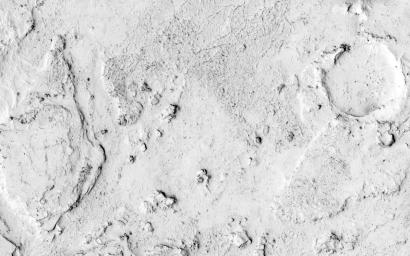
|
Channel in the Cerberus Palus Region
- Click the image above for a larger view
- Full-Res JPEG (2880 x 1800) (790.8 kB)
- Full-Res TIFF (2880 x 1800) (5.2 MB)
Caption:
This image shows the end of a small channel near Athabasca Valles on Mars. Athabasca is an example of a Martian "outflow channel," likely carved by a massive flood of groundwater. However, it is now coated with a thin veneer of lava, following a massive volcanic eruption that flowed down the channel.
This smaller channel is also covered by the same lava flow. It might have originally been carved by water and later draped by lava that partially drained away, but it is also possible that hot, swift lava cut down into the ground. In either case, the reason a channel formed here is the ridge running across the image. Once fluid reached the top of this ridge, flow was concentrated there and carved a deeper channel.
The upstream half of the channel is visible in PSP_008265_1860 .
Background Info:
HiRISE is one of six instruments on NASA's Mars Reconnaissance Orbiter. The University of Arizona, Tucson, operates the orbiter's HiRISE camera, which was built by Ball Aerospace & Technologies Corp., Boulder, Colo. NASA's Jet Propulsion Laboratory, a division of the California Institute of Technology in Pasadena, manages the Mars Reconnaissance Orbiter Project for the NASA Science Mission Directorate, Washington.
Cataloging Keywords:
| Name | Value | Additional Values |
|---|---|---|
| Target | Mars | |
| System | ||
| Target Type | Planet | |
| Mission | Mars Reconnaissance Orbiter (MRO) | |
| Instrument Host | Mars Reconnaissance Orbiter | |
| Host Type | Orbiter | |
| Instrument | High Resolution Imaging Science Experiment (HiRISE) | |
| Detector | ||
| Extra Keywords | Grayscale, Volcano, Water | |
| Acquisition Date | ||
| Release Date | 2013-07-17 | |
| Date in Caption | ||
| Image Credit | NASA/JPL-Caltech/Univ. of Arizona | |
| Source | photojournal.jpl.nasa.gov/catalog/PIA17697 | |
| Identifier | PIA17697 | |
